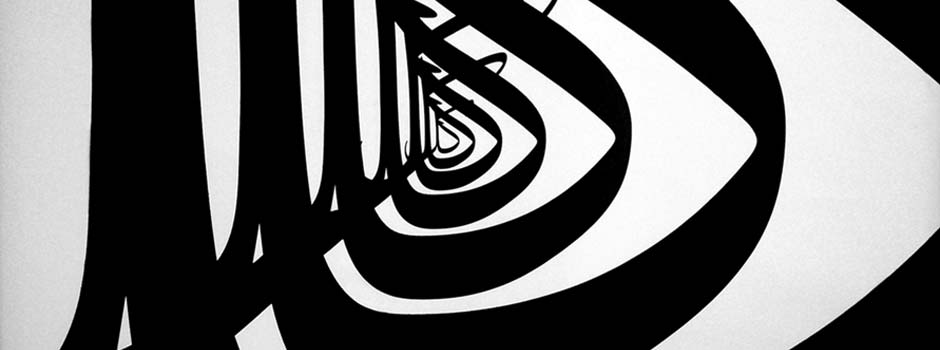
Jameel Prize 3 Shortlist Announced
Mar 14, 2013 Art News

Almost 270 nominations for the Jameel Prize 3 were received from countries as diverse as Algeria, Brazil, Kosovo, Norway and Russia. A panel of judges, chaired by V&A Director, Martin Roth, selected the shortlist of ten artists and designers. Martin Roth said: “This, the 3rd Jameel Prize, has continued to attract nominations from around the world, and for the first time the shortlist features work from Saudi Arabia, Azerbaijan and India. The Jameel Prize 2011 touring exhibition has also attracted a wide audience, showing in America, Spain and France to more than 20,000 visitors. We are delighted to continue our work on the Jameel Prize with Abdul Latif Jameel Community Initiatives (ALJCI)â€.
The work of the shortlisted artists and designers will be shown at the V&A from 11 December 2013 until 21 April 2014. The shortlist is diverse but all the artists and designers are directly inspired by sources rooted in the Islamic tradition. The works on show will range from Arabic typography and calligraphy to fashion inspired by the Hagia Sofia in Istanbul and from social design and video installation to delicate and precise miniature drawings. A short film about the artists and designers work can be viewed online HERE.
The winner of the Jameel Prize 3 will be announced at the V&A on 10 December 2013. Huda Smitshuijzen AbiFarès, Founding Director of the Khatt Foundation is a judge for this year’s prize. She commented: “The shortlist features diverse and strong contemporary design work. We selected work that could set a trend in advancing new ways of interpreting Islamic art in a contemporary context as well as its relevance to society and its impact on generations to come. The experimental use of material and techniques, the clarity of message, the simplicity and purity of form, the precision of craft, and the social implications, were all taken into consideration. It is exciting to see that the selected works although referencing traditional Islamic culture, also reflect universal design concerns and fresh new ideas."
The Jameel Prize is a £25,000 international art prize for contemporary artists and designers inspired by Islamic traditions of craft and design. Launched in 2009, the winner of the first Jameel Prize was Afruz Amighi for her work 1001 Pages (2008), an intricate hand-cut screen made from the woven plastic used to construct refugee tents. In 2011 the winner was Rachid Koraïchi, for his work Les Maitres Invisibles, (The Invisible Masters, 2008), a selection of embroidered cloth banners which display Arabic calligraphy and symbols and ciphers to explore the lives and legacies of the 14 great mystics of Islam.
The Jameel Prize is sponsored by Abdul Latif Jameel Community Initiatives (ALJC I). The prize was conceived after the renovation of the V&A’s Jameel Gallery of Islamic Art, which opened in July 2006. The gallery is an outstanding presentation of the rich artistic heritage of the Islamic world, and the prize aims to raise awareness of the thriving interaction between contemporary practice and this great historical heritage. It has also contributed to a broader understanding of Islamic culture and its place in the world.
Award-winning architect Dame Zaha Hadid is Patron of the Jameel Prize. The judges are: Thomas Heatherwick, designer and founder of Heatherwick Studio, Rashid Koraïchi, winner of the Jameel Prize 2011 Martin Roth, V&A Director Nada Shabout, Associate Professor of Art History and the Director of the Contemporary Arab and Muslim Cultural Studies Institute (CAMCSI) at the University of North Texas, USA Huda Smitshuijzen AbiFarès, Founding Director of the Khatt Foundation, Center for Arabic Typography.
Faig Ahmed works in a variety of media including painting, video and installation but will exhibit two works Hollow (2011) and Pixelate Tradition (2012) from his current Azerbaijani traditional rug making. Ahmed disassembles the rug’s conventional structure and randomly rearranges the components of the traditional composition often combining these fragments with contemporary sculptural forms. The carpet is a traditional symbol of the East, but Ahmed makes slight changes in the form of the carpet to dramatically change its structure and to make it more suitable for modern life. Faig Ahmed was born, lives and works in Baku, Azerbaijan.
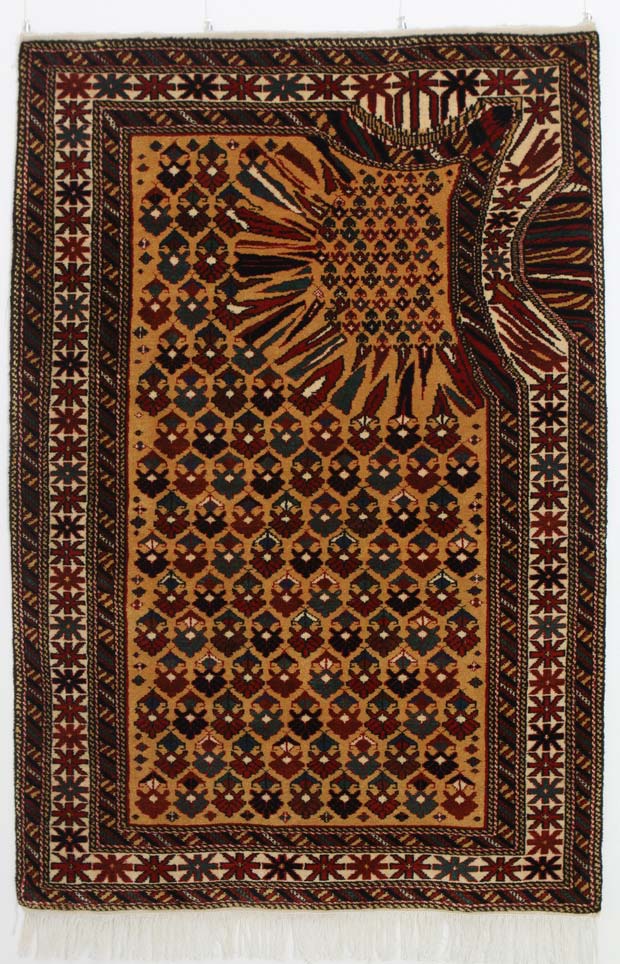 Hollow by Faig Ahmed, 2011 / Courtesy of YAY! Gallery, Photo Fakhriyya Mammedova
Hollow by Faig Ahmed, 2011 / Courtesy of YAY! Gallery, Photo Fakhriyya Mammedova
Nada Debs is a renowned Lebanese furniture and product designer. She will exhibit Concrete Carpet (2010), a large scale work which celebrates her blend of Middle Eastern craftsmanship with Far Eastern philosophy. Debs mixes concrete inlaid with mother-of-pearl to create a seemingly traditional Persian carpet made with modern materials. The carpet is divided into 28 panels, similar to Japanese Tatami mats, each panel featuring a letter of the Arabic alphabet. The font used in the design was developed in collaboration with Arabic type designer and typographer Pascal Zoghbi (also shortlisted for the Jameel Prize 3) as a corporate font for her business. Her use of abstract repetitive patterns is typical of Islamic geometry and is a major feature in this piece. Debs was born in Japan and lives and works in Lebanon.
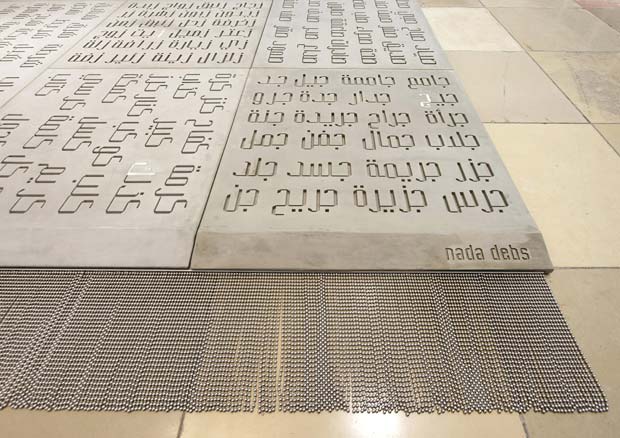 Concrete Carpet by Nada Debs, 2010 / Courtesy of Mathaf, Photo Marino Solokhov
Concrete Carpet by Nada Debs, 2010 / Courtesy of Mathaf, Photo Marino Solokhov
Mounir Fatmi will show a video work entitled Modern Times: A History of the Machine (2010-12). Fatmi attempts to create a dialogue between traditional Arabic calligraphy, European legacy and the recent urbanisation in the Middle East. Modern Times explores architecture in the Middle East, raising the question of the human impact of ‘unrelenting’ construction. His work often highlights a fraught relationship with architecture and the dystopic effects of contemporary displays of power and economic might. The arabesques of Arabic calligraphy are a recurring motif in his work but a layer of ambiguity eclipses the meaning of the words, as if the message were disappearing into the engine of a machine. Mounir Fatmi was born in Morocco and lives and works between Paris and Tangier.
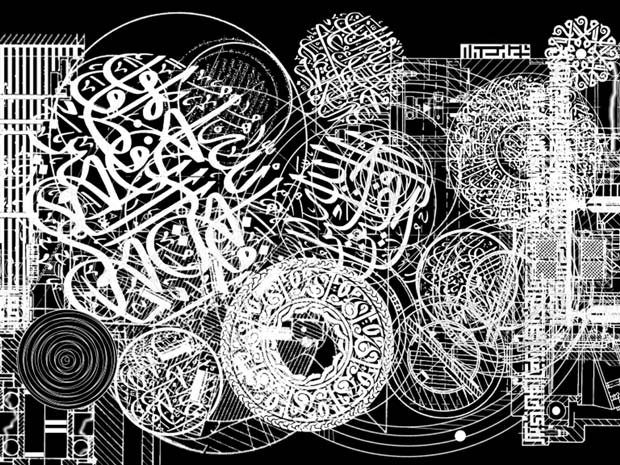 Modern Times, a History of the Machine by Mounir Fatmi, 2010-2012 / Courtesy of the Artist and Shoshana Wayne Gallery, Santa Monica
Modern Times, a History of the Machine by Mounir Fatmi, 2010-2012 / Courtesy of the Artist and Shoshana Wayne Gallery, Santa Monica
Rahul Jain is textile designer and historian who in 1993, set up the world’s only drawloom workshop that re-creates Mughal silks of the 17th and 18th centuries. He will show two works The Snow Leopard (2007) and The Birds of Paradise (2008). Based in Varanasi, India, the workshop comprises five traditional Indian drawlooms that are operated by local Muslim weavers. Under Jain’s technical and artistic supervision, the craftsmen specialise in the weaving of museum-quality patterned silks in the complex historical techniques of taquete/samite, lampas, double-cloth and velvet. In keeping with local tradition, their design repertoire draws inspiration from historical Indo-Iranian textiles, while re-interpreting traditional imagery and inventing new content. By maintaining the mathematical discipline of the classical art, the repertoire remains grounded in the austere geometry that lies at the heart of Islamic décor. The woven images, motifs, and textures are inspired by Mughal, Safavid and Ottoman silks and made in pure silk, gold and silver. As a centuries-old Indo-Iranian art nears extinction, they also represent the last attempt to preserve, locally, an extraordinary body of drawloom-weaving skills and techniques, and to extend into the future a tradition of outstanding craftsmanship. Rahul Jain was born, lives and works in New Delhi, India.
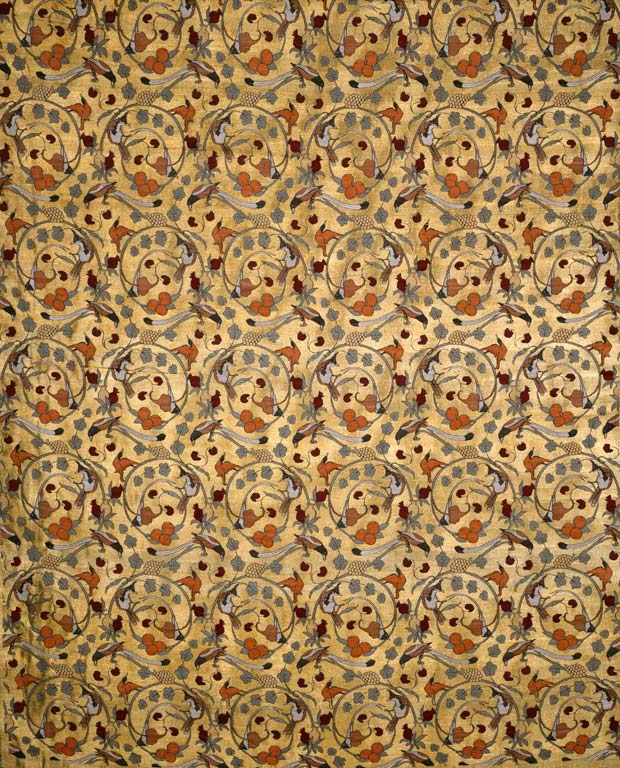 The Birds of Paradise by Rahul Jain, 2008 / Courtesy of Lekha and Ranjan Poddar collection, New Delhi. Photo Ashok Dilwal
The Birds of Paradise by Rahul Jain, 2008 / Courtesy of Lekha and Ranjan Poddar collection, New Delhi. Photo Ashok Dilwal
Dice Kayek is one of Turkey’s most well known fashion labels and will show three garments from Istanbul Contrast, (2010), a collection of 19 couture pieces which draws inspiration from Istanbul’s Islamic heritage in architecture, arts and crafts and its rich religious and cultural diversity. Caftan, a lamé hand-woven brocard, plays homage to Ottoman sartorial style as a symbol of status, power and honour. Dome is a light-weight cotton organdi dress entirely folded by hand which brings to mind the layers of domes of the Hagia Sofia, one of the most significant buildings of Istanbul’s Islamic heritage. Hagia Sofia is inspired by the interior of the mosque; a white satin coat, its complex embroidery stitched entirely by hand with antique blown glass beads. Established in 1992 by sisters Ece and Ayse Ege, the brand reflects its Turkish origins, bridging east and west, the traditional and the modern, as well as the luxurious and the sober. Each collection piece is an abstract contemporary vision extracted from this patrimony, translating itself into a line, structure, crease, fold, drape, and embellishment; transforming this aesthetic vision into a sculptural garment. Ece and Ayse Ege were born in Bursa, Turkey and live and work between Istanbul and Paris.
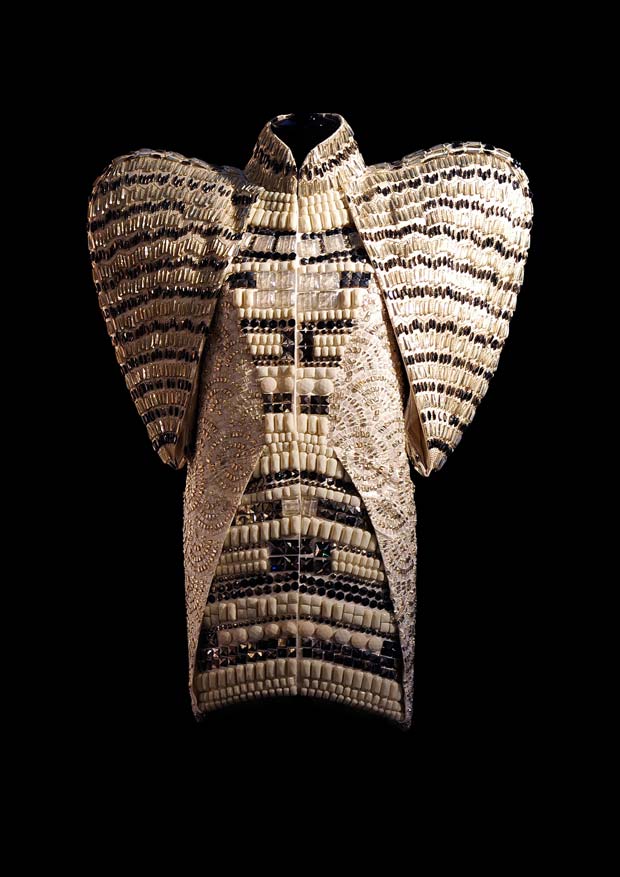 Hagia Sofia by Dice Kayek, 2009 / Courtesy of Dice Kayek, Photo Dice Kayek Archive
Hagia Sofia by Dice Kayek, 2009 / Courtesy of Dice Kayek, Photo Dice Kayek Archive
Waqas Khan is an artist who is trying to challenge traditional miniature painting by presenting small scale miniature drawings in large scale. He will show two works Tranquil Pool, (2012) and Dance in retina II, (2012) which exemplify how he employs dots, marks and lines to express himself and to give the viewer the opportunity to enjoy the beauty of visual infinity. Khan’s work is extraordinarily precise and delicate. He does not use magnifying glasses and usually works at night. He holds his breath whilst drawing and exhales only after the ink is on the paper. This long process drives him into a trance-like state which enables him to create works that evolve from simple dots into organic structures, patterns and compositions with a deceptive simplicity. His drawings are built up from ideas and concepts obtained from Muslim, Hindu and Sufi traditions. Waqas Khan was born, lives and works in Lahore, Pakistan.
 Tranquil Pool by Waqas Khan, 2012 / Courtesy of the Artist and Sabrina Armani Art Gallery
Tranquil Pool by Waqas Khan, 2012 / Courtesy of the Artist and Sabrina Armani Art Gallery
Laurent Mareschal will display a new site specific work entitled Beiti (2013). Mareschal often uses ephemeral materials such as spices, soap and food in his work as a powerful way to evoke our own fragility and remind the viewer that nothing lasts. In the presence of these fragile raw materials, Mareschal invites the audience to participate and even transform his work. A triggering of the senses might result in a sneeze above some tiling composed of fragrant spices or a breath before lines of brown sugar, leading to these elements being displaced. His work is often a replica of decorative ceramic tiles from an old Palestinian house or traditional Palestinian embroidery. Laurent Mareschal was born, lives and works in France.
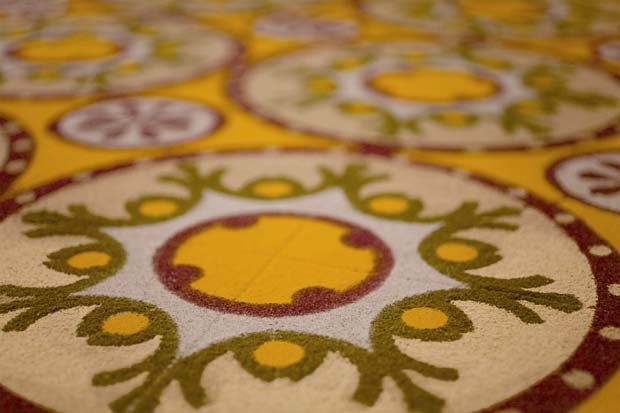 Beiti by Laurent Mareschal, detail, 2011 / Courtesy of the Artist and Galerie Marie Cini, Photo Tami Notsani
Beiti by Laurent Mareschal, detail, 2011 / Courtesy of the Artist and Galerie Marie Cini, Photo Tami Notsani
Nasser Al Salem is a calligrapher who works specifically with the Arabic written word. He will show two works Kul (2012) and Kul I (2012), which reflect both his use of mixed media but also the tradition of ink on paper. This expression, meaning ‘all,’ ‘everything’ or ‘infinite’, is represented repeatedly to create an endless ripple effect that is not only associated with the abundance of God’s creation but suggests deeper interpretations. Nasser’s practice is a personal form of devotion, but he also aims to prompt the viewer to re-think their definition of Arabic calligraphy and to dispel the notion that it is limited to the category of Islamic art and craft. He sees calligraphy has having farreaching conceptual potential and an influential role to play in contemporary artistic practice. Nasser Al Salem was born, lives and works in Saudi Arabia.
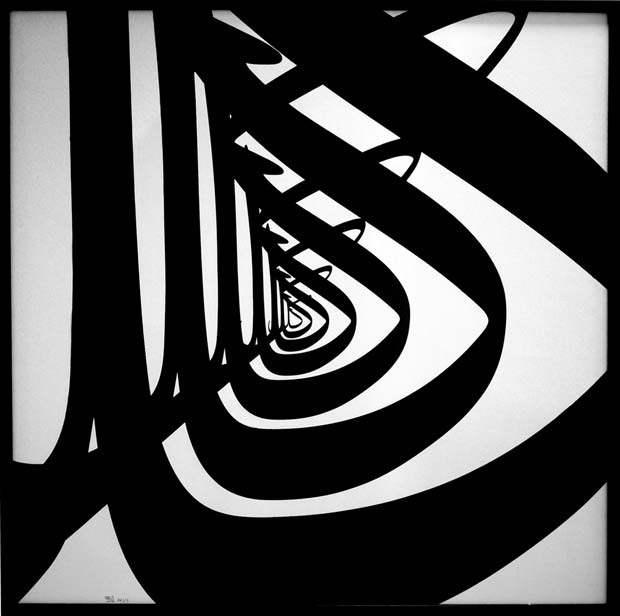 Kul by Nasser Al Salem, 2012 / Courtesy of the Artist and Athr Gallery
Kul by Nasser Al Salem, 2012 / Courtesy of the Artist and Athr Gallery
Florie Salnot will exhibit jewellery designs from Plastic Gold (2010-ongoing), a project inspired by the traditional ornaments of the Saharawi women of the Sahara desert. Salnot developed a technique, specifically designed to transform discarded plastic bottles into pieces of jewellery, that could be practiced within the barren conditions of the Saharawi refugee camps in Algeria. The technique uses only hot sand, simple hand tools and some paint. Plastic Gold aims to empower the Saharawis both economically and culturally by enabling them to practice craft activities despite the lack of traditional resources. The necklaces and bracelets on display stand as an example of how this could be done. Their patterns are characterised by a multiplicity of geometrical shapes that were traditionally drawn on leather and metal. Florie Salnot was born in France and lives and works between Hamburg, London and Paris.
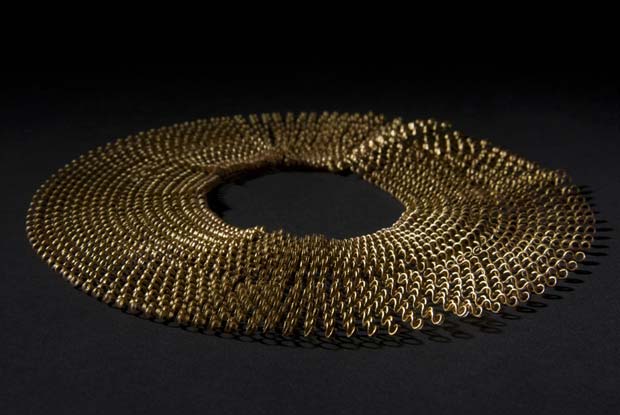 Plastic Gold by Florie Salnot, 2010 / Courtesy of Florie Salnot, Photo Dominic Tschudin
Plastic Gold by Florie Salnot, 2010 / Courtesy of Florie Salnot, Photo Dominic Tschudin
Pascal Zoghbi is an Arabic type designer and typographer creating new Arabic fonts, corporate identities and print publications. He is one of only a few designers working in the relatively new discipline of contemporary Arabic typography. Zoghbi will exhibit examples from his 29LT Fonts Collection. He is the founder of 29letters, an Arabic type design and typography firm in Beirut which has created Arabic fonts for leading Middle Eastern newspapers and magazines; urban spaces such as Abu Dhabi Airport Terminal 3; art events such as Contemparabia and software including Droid from Google. His work refers to the traditional Arabic calligraphic style and his challenge is to draw the new fonts in a contemporary way yet in line with the structure and proportions of traditional letters. Depending on the design brief of the project, he will choose which traditional style of Arabic calligraphy such as Kufic, Naskh, Thuluth, Diwani or Ruqaa to base his design on. He might also make a hybrid type based on two styles. Understanding the traditional calligraphic styles and comprehending the proper structure of each style is a key aspect for a contemporary Arabic type designer. Pascal Zoghbi was born and lives and works in Lebanon.
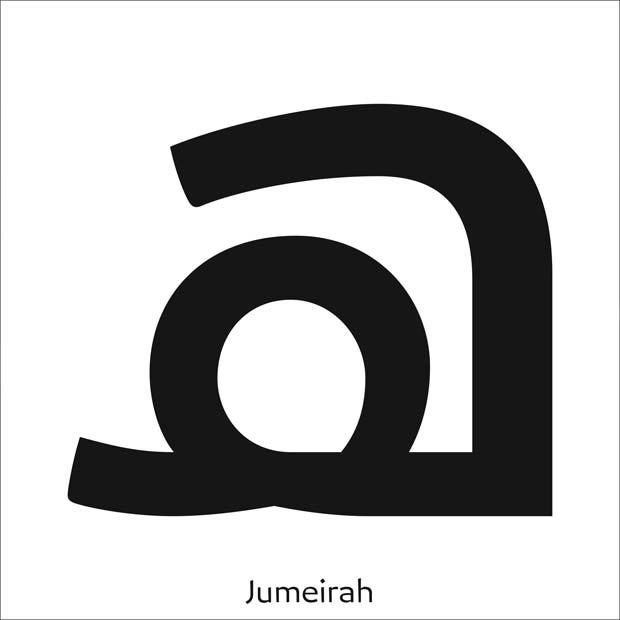 Arabic Letter Ha' by Pascal Zoghbi, 2012 / Courtesy of the Artist
Arabic Letter Ha' by Pascal Zoghbi, 2012 / Courtesy of the Artist
The V&A has specialised in collecting Islamic art since the 1850s, and was the first institution in the world to collect Islamic art in a systematic fashion. In the late 1800s the V&A was very interested in contemporary practice in the Middle East particularly through the work of Robert Murdoch Smith in Iran. The V&A has revived that interest through the Jameel Prize. The Jameel Prize is also part of the V&A’s programme of activities designed to develop cultural links around the world and promote cultural understanding.
Leading curators, designers, artists and cultural figures from across the world were invited to nominate applicants to the Jameel Prize. Almost 270 nominations were received from which a shortlist of ten artists and designers was drawn up by the judging panel.
In 2003 Abdul Latif Jameel Community Initiatives (ALJCI) was founded. From individual, community and Arab life as a whole in Saudi Arabia and beyond, ALJCI has the welfare of individuals and community at heart. By promoting Arab arts and culture in the Middle East and around the world, working against the unemployment epidemic, enabling research for poverty alleviation, and providing education and training opportunities, ALJCI has successfully promoted positive social change. Today it supports and partners with global institutions, which employ hundreds of people, all aiming to provide people with opportunities and training to pursue their career dreams and to challenge rising levels of unemployment.
Comments
Add a comment